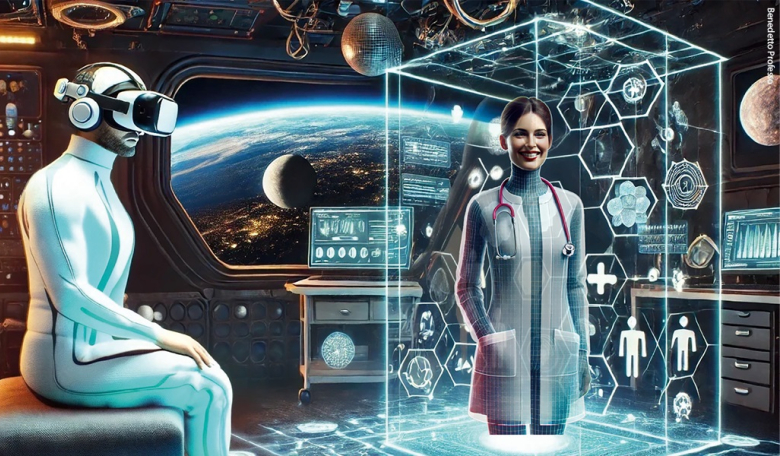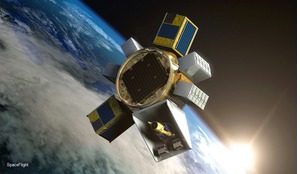The Metaverse is a term used to describe the convergence of physical and virtual space accessed through computers and enabled by immersive technologies such as virtual reality (VR), augmented reality (AR) and mixed reality (MR). It has the potential to transform and reshape our approach to healthcare, both on Earth and in space, as human exploration expands beyond low Earth orbit to the Moon and Mars.
Much like the internet has changed the way we interact, the Metaverse is changing the way we communicate, learn and address health concerns. Imagine a space where virtual environments replicate real-world scenarios, enabling scientists and medical professionals to simulate complex scenarios, collaborate and innovate in ways previously unimaginable. Space agencies, such as the National Aeronautics and Space Administration (NASA) and the European Space Agency (ESA), are already applying Metaverse technologies for space endeavours, with private companies simultaneously working towards virtual innovation.
Within healthcare, the Metaverse has the potential to dismantle geographical barriers to enhance access to healthcare professionals, decentralise clinical trials and empower remote diagnostics. It will do this via immersive therapy, medical education and clinical assessments using the simulation of operating rooms, medical equipment or human anatomy.
In fact, the Metaverse has already stimulated a remarkable surge in healthcare applications, driven by the widespread adoption of telemedicine during the COVID-19 pandemic. This shift is part of a broader trend in the healthcare sector, where the integration of telemedicine and immersive medical training and education are experiencing significant growth. According to projections by Precedence Research, the global Metaverse in Healthcare market was estimated at US $7.5 billion in 2022, with expectations to reach $75.76 billion by 2031, reflecting a compound annual growth rate (CAGR) of 29.4 percent (see Figure 1). Similarly, Vantage Market Research’s forecast suggests a strong CAGR of 52.9 percent, with the market valued at $9.5 billion in 2023 and expected to reach $79.6 billion by 2028.
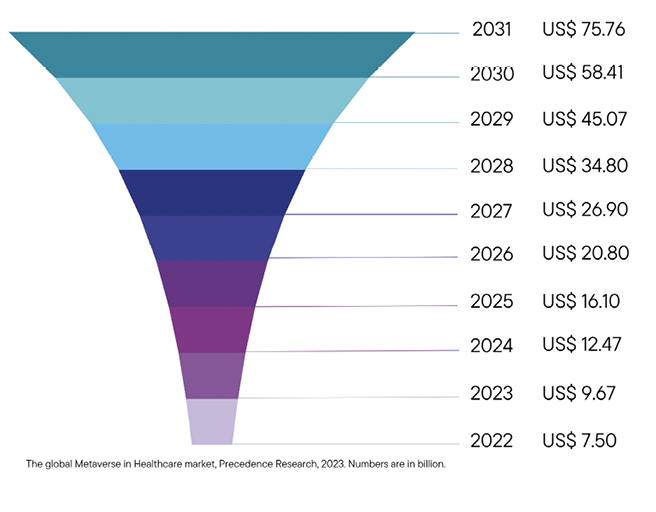 Figure 1: Metaverse healthcare market projected growth.
Figure 1: Metaverse healthcare market projected growth.
Telemedicine in space
The Metaverse has the potential to transform and reshape our approach to healthcare, both on Earth and in space
In the realm of space exploration, telemedicine has served as a fundamental approach for delivering healthcare since the beginning of human space travel, by connecting crewmembers with physicians on the ground. With the Metaverse, real-time interaction between astronauts and their medical team could determine the difference between swiftly resolving an emergency or encountering a dangerous situation. On Earth, telemedicine is now an integral component of the modern healthcare system, allowing medical professionals to remotely conduct patient assessments via live communications.
By integrating artificial intelligence (AI) within the Metaverse, managing massive medical data and images becomes possible, providing medical professionals with another way to interact with patients and visualise and diagnose health conditions, while providing guidance to astronauts and ensuring their wellbeing, even with huge distances of separation between them.
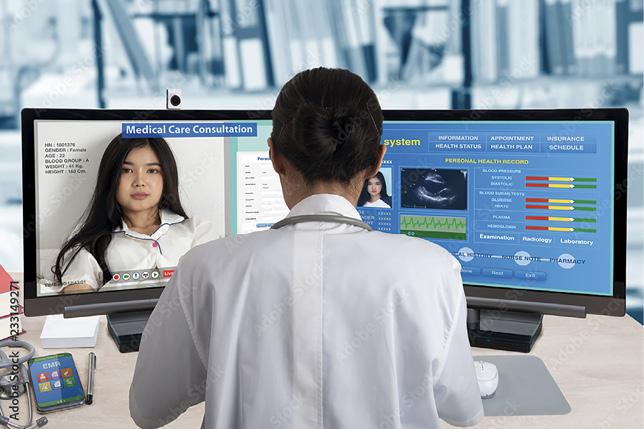 Virtual medical care consultations are increasingly common today, allowing time-saving and, in some cases, life-saving diagnostics.
Virtual medical care consultations are increasingly common today, allowing time-saving and, in some cases, life-saving diagnostics.
The breadth and depth of the medical training that astronauts receive is limited, so there is a need for diagnostic tools that are intuitive to use and operate with minimal (or even zero) human input. The Metaverse offers a creative way to assist space crews in diagnosing, assessing and treating spaceflight-associated medical conditions. It also has additional capabilities as a training tool and can help to combat skill decay and knowledge gaps.
GE Healthcare’s wearable biomedical devices have been used to enable NASA flight surgeons to monitor astronauts’ health in real-time during critical aspects of missions, such as spacewalks, and allow for further analysis of data such as vital signs, sleep patterns and overall health status. Several devices now exist, including from companies such as Garmin, Apple and Samsung, expanding the potential for remote biomonitoring on Earth or in space.
Beyond the transmission of real-time health data from astronauts to medical centres on Earth, similar AI monitoring systems are now being applied to collect, analyse and distribute health data from high-risk patients at home, so that medical issues can be monitored and detected early, allowing for timely intervention.
Diagnostics
The Metaverse offers creative solutions as a diagnostic assistive device, especially when combined with other emerging technologies such as AI. On Earth, AI tools are already being used to help detect medical conditions, analyse large scale data, recognise patterns in medical imaging and interpret text (such as from radiology reports or other digital health files). Additionally, health-tech companies, such as LuxSonic, are using VR to provide an immersive experience for radiology, medical education and training.
Tools incorporating these technologies are also being developed for use in space. For instance, NASA is currently developing a self-guided VR tool, which uses AI to help diagnose spaceflight associated neuro-ocular syndrome (SANS). This eye condition, attributed to increased intracranial pressure during space travel, poses significant challenges during prolonged spaceflight. By harnessing AI-driven analysis of biometric data, this tool allows for remote assessment of SANS manifestation and diagnosis. Its capability to eliminate the necessity of physical presence significantly enhances the efficiency and accessibility of medical evaluations in space-related health concerns. Moreover, beyond its diagnostic capabilities, combining AI with VR/AR holds promise for training and supporting non-medical crew members and ensuring skill maintenance during long-duration space missions.
Education Training
AR and VR technologies have helped address isolation and confinement during multiple trials, showing promise for applications in space
The Metaverse can also be used for crew training and long-term management of medical conditions. With commercial space flight now a reality, a wider range of people are flying to space, and the risk of people experiencing an adverse medical scenario is therefore increasing. Prevention is key in ensuring the wellbeing of passengers and crew, and imaging modalities such as ultrasound are extremely important. This means that it is important for all crew members to understand how to perform an ultrasound examination, especially as this is the only reliable form of imaging conducted in space. Both VR and AR have been used to guide non-medical professionals through procedures with success.
Beyond their use as a tool to teach relatively simple medical tasks, virtual and augmented reality can also be used to demonstrate the placement of hands and where to cut in surgical procedures and how to insert an endotracheal tube into an airway. They can display targets that show where to place shock pads for a defibrillator, where to insert a chest tube, needle or catheter, and more.
There are also important applications on Earth in medical education for trainees during various stages of their careers and many institutions are already developing devices and resources for these purposes. For example, researchers at the University of Alberta in Canada have been working to create virtual technology for healthcare, such as via ProjectDR or TeleRehab 2.0, which consists of motion sensors and robotics to conduct rehabilitation assessments, or motion tracking and infrared cameras for use in medical imaging to display data of a patient’s internal anatomy onto their body. And soon, physicians will be able to use this to help with surgical planning and teaching.
Additional tools, such as UbiSim, have been developed using virtual reality for nursing education, with adjustable parameters to maximise its capability for training. Further, AR can be used to help medical professionals develop soft skills, such as empathy and interpersonal communication, by teaching cue recognition. This would also be useful as a training application for astronauts, who work in highly multicultural and diverse environments.
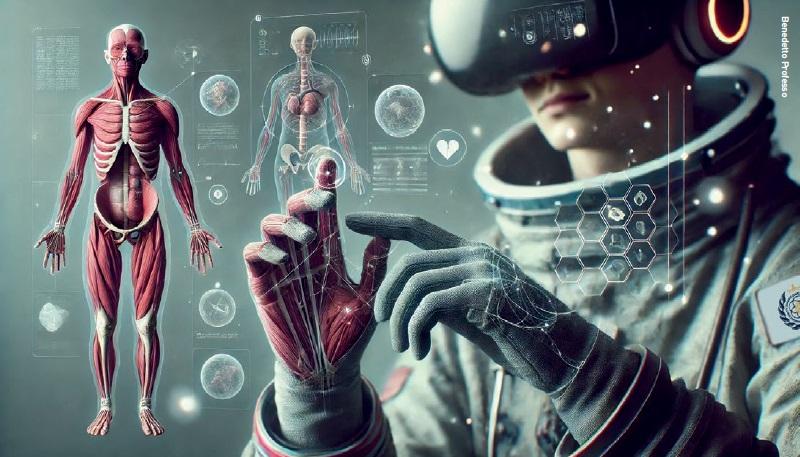 The Metaverse is set to revolutionize space medicine for future space travellers through virtual and augmented reality.
The Metaverse is set to revolutionize space medicine for future space travellers through virtual and augmented reality.
Countermeasures
Countermeasures are defined, in this context, as solutions to prevent adverse psychological and/or physiological problems associated with spaceflight. Astronauts experience many psychological challenges in the spaceflight environment, such as isolation, confinement, limited personal space, burnout, monotony, loneliness and altered day/night cycles which affects mood, quality of sleep and cognition.
Despite the existing psychological and behavioural countermeasures in use, mental health challenges are still widely experienced by crewmembers, making it important to develop additional techniques to maintain mental wellbeing. AR and VR technologies have helped address isolation and confinement during multiple trials, showing promise for applications in space.
When therapeutic techniques are combined with VR, a uniquely catered and consistent environment can be created to meet the personal needs for every patient. For astronauts in space, using VR for therapy could offer a more personal and interactive environment than a video or voice call, potentially making the experience more comfortable or effective. VR can be used to slowly introduce stimuli, create meditative spaces, recreate nature and the outdoors, or even simulate increased personal space. This could provide psychological relief to astronauts who are otherwise in relatively small and often crowded spaces during their missions.
The Metaverse offers creative solutions as a diagnostic assistive device, especially when combined with other emerging technologies such as AI
Astronaut training with VR and AR is being utilised for some critical activities on the International Space Station (ISS), including controlling robots and performing scientific experiments. In 2021, NASA and ESA investigated the use of VR to recreate three-dimensional immersive environments on the ISS for astronauts while they were using the CEVIS exercise bicycle.
Though the use of VR is not yet a permanent fixture aboard the ISS for exercise, there is literature to support the theory that the gamification of exercise via VR can positively impact emotions while simultaneously decreasing anxiety. Though exercise may be thought of as a physical countermeasure against bone and muscle losses, it is also known to positively affect neurophysiology and to enhance overall mood. Preliminary studies have shown the effects of exergaming (incorporating VR into exercise) more specifically on the wellbeing of astronauts, showing its potential for enhancing mood and cognition in space. Additionally, beyond being used with the bicycle on the ISS, VR could be combined with multi-directional treadmills or other workout equipment, to provide variation in movement.
In hospitals, VR is being used in rehabilitation and pain management to help decrease stress, discomfort and feelings of anxiety, by distracting patients during painful procedures and from hostile environments such as intensive care units. As journeys to space get longer, tools for rehabilitation and pain management could prove very useful.
Nutrition and the provision of food plays a pivotal role as a countermeasure in spaceflight, where maintaining health and performance is essential. Fresh food is so important to mental wellbeing on the ISS that astronauts get a delivery of fresh fruits and vegetables with each re-supply vehicle. Virtual environments can simulate eating experiences, helping astronauts adapt to new eating habits and manage stress-related dietary changes during deep space missions. Research shows that the Metaverse is able to stimulate human senses in real time, particularly visual and auditory. Moreover, an immersive mixed reality can improve research on human eating behaviour to better mimic the eating experience in the real-world setting of a café or restaurant, rather than the sterile laboratory setting.
Eating behaviour is strongly influenced by interpersonal factors as well as the external eating environment, and since a virtual environment can influence a multitude of senses, food choice can therefore be influenced by both immersive and semi-immersive technologies. The Metaverse creates a space where an astronaut can virtually enjoy a meal with those most meaningful to them, such as friends and family, therefore also contributing to their cultural, social and psychological needs.
MR allows astronauts to interact with their food, while immersed in a completely different environment, which can be controlled and manipulated as required. By analysing astronauts’ physiological data, including metabolism and nutrient requirements, the Metaverse can assist in tailoring and adapting to individualised nutrition plans. The Metaverse can become a place where scientists virtually research food sources such as plants, or design and test space-friendly, nutrient-rich foods.
Future outlook and challenges
Governments and space agencies should work together to develop clear legal frameworks for the use of VR/AR technologies in healthcare
The future of VR/AR in space medicine is expected to be significantly impacted by advancements in technology (see Figure 2). As the use of VR/AR in healthcare continues to grow, it is crucial to address the challenges related to data security, privacy and legal liabilities. The decentralised nature of the internet and the lack of clear legal frameworks in the virtual reality space make it difficult to establish consistent regulations and guidelines for the use of these technologies in healthcare. Furthermore, the vulnerability of sensitive financial and medical information on VR/AR devices raises concerns about the protection of sensitive information in the space medicine context.
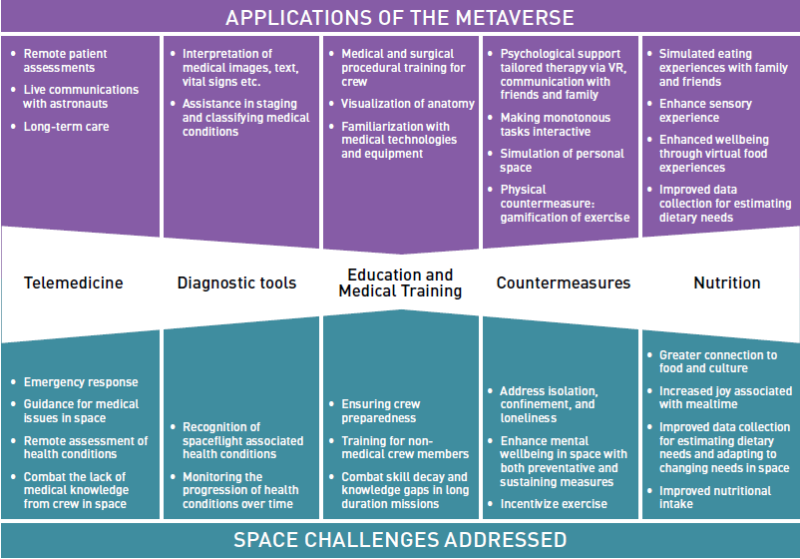 Figure 2: Applications and space challenges addressed via implementation of the Metaverse in space medicine.
Figure 2: Applications and space challenges addressed via implementation of the Metaverse in space medicine.
To navigate these challenges responsibly, proactive measures, collaborative efforts and regulatory advancements are needed. For instance, governments and space agencies should work together to develop clear legal frameworks for the use of VR/AR technologies in healthcare, ensuring that the technology is used responsibly and that patients’ privacy and data security are protected. Additionally, the healthcare sector should invest in advanced security measures to safeguard sensitive information and minimise the risk of cyber security threats in space medicine.
By addressing these challenges and embracing the potential benefits of virtual medical systems, the future of space medicine could witness significant advancements in healthcare delivery, training and research. This will not only improve the wellbeing of astronauts but also pave the way for safe and sustainable deep space explorations and game-changing terrestrial applications for use in remote, rural and urban environments.
About the authors
Brittany Wiseman is a medical student at the University of Alberta, Canada. She has a BSc in Molecular Genetics & Cellular Biology and recently completed the International Space University Space Studies Program (SSP23) in Brazil. She is also a private pilot, currently working towards her commercial license.
Dr Flávia Fayet-Moore is a Brazilian-born, Canadian-raised, Australian-made scientist, dietitian, space nutritionist and entrepreneur. She has dedicated her 20+ year career to performing and translating nutrition research which makes a public health impact. As founder and CEO of FOODiQ Global, she leads food and nutrition research, education and communication. She is also the co-founder of Food is Cool.
Marie-Louise Hohenbühel is an MSc student in International Law and Security at NOVA School of Law (NSL) and a recent graduate of the International Space University Space Studies Program (SSP23), where she contributed to research on the use of the Metaverse in the space sector.
Dr James Green is the Chief Scientist of the Metavisionaries. Having gained a PhD in Physics from the University of Iowa in 1979, he worked at Marshall Space Flight Center, Goddard Space Flight Center and NASA Headquarters before retiring in December 2022. During his 42-year career at NASA, Jim was NASA’s Chief Scientist and was the longest serving director of the Planetary Science Division.





